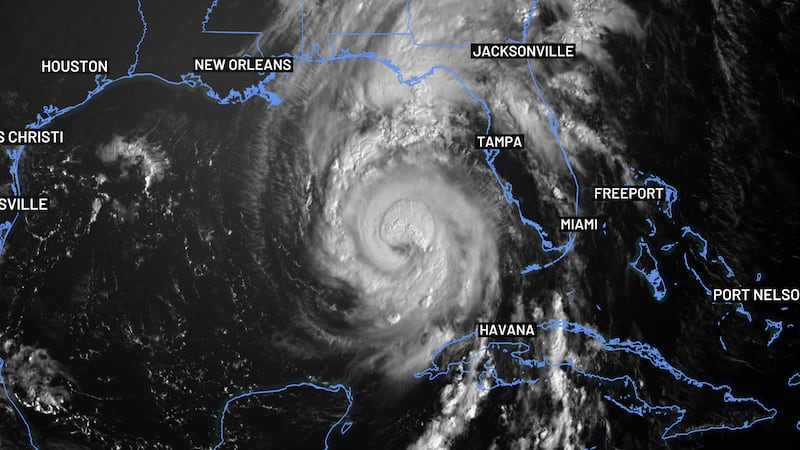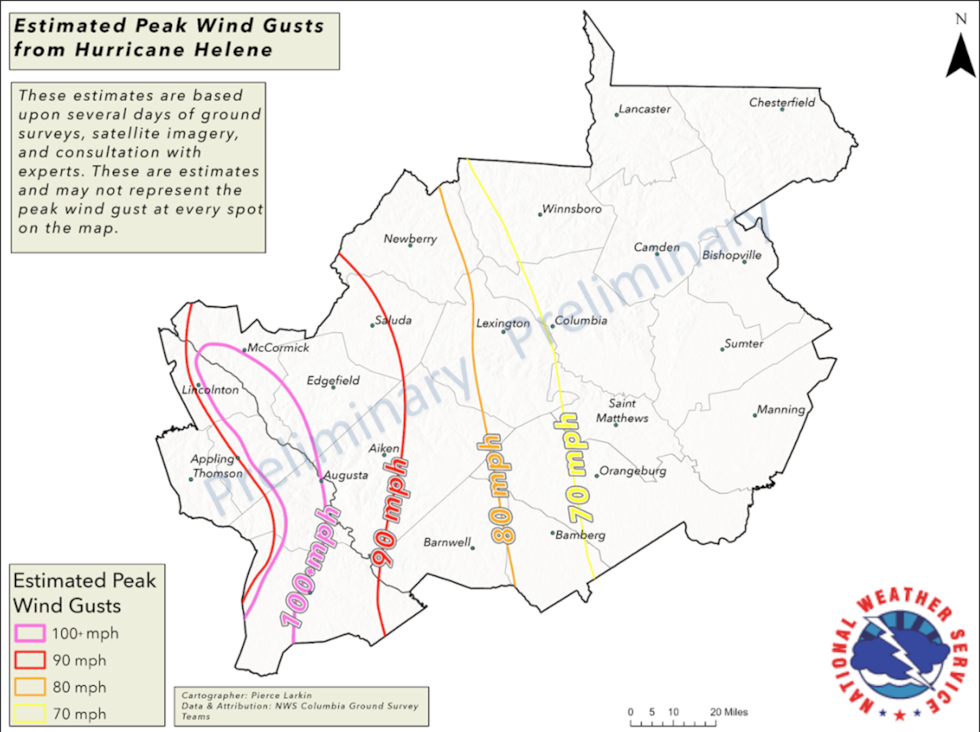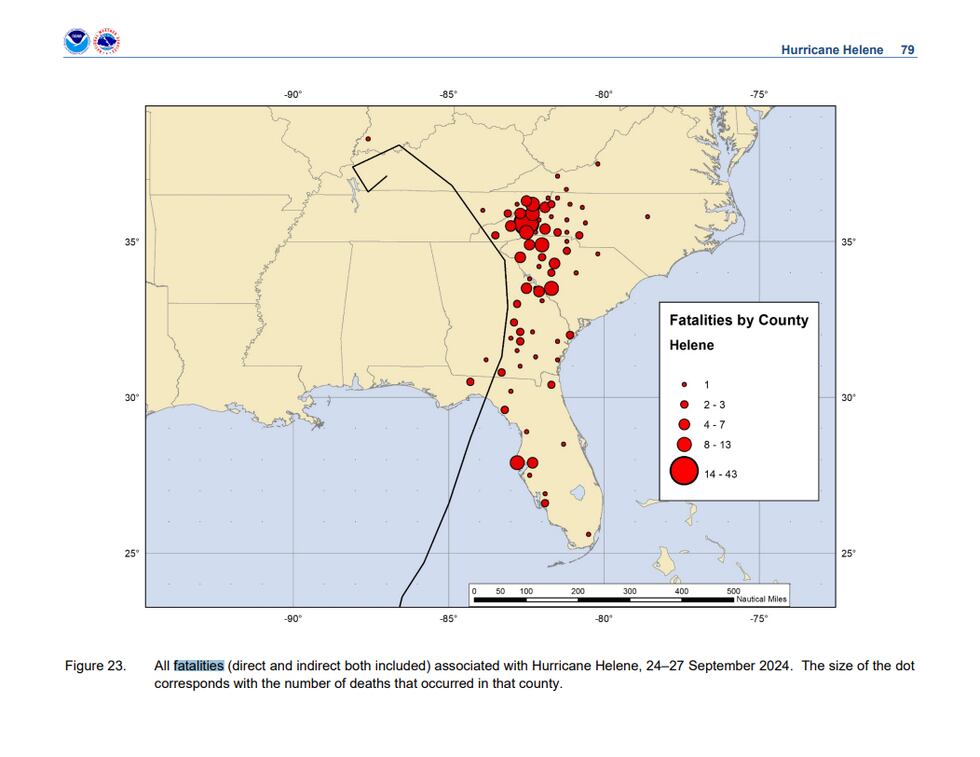Weather Blog: NOAA NHC releases full report on Hurricane Helene

AUGUSTA, Ga. (WRDW/WAGT) - The NOAA National Hurricane Center has released their full report and analysis on Hurricane Helene. This tropical system changed the landscape of the CSRA along with many areas from the southeastern United States all the way up to the Midwest.
Here are some key takeaways for our region from the 107 page long report -
Per NOAA NHC:
“In South Carolina, the mountainous regions in the northwest part of the state and the western portion of the Piedmont suffered the most damage, due to the widespread hurricane force and near-hurricane-force wind gusts and scattered areas that experienced major flooding. Areas along and to the northwest of a line from Charlotte, North Carolina to Columbia, South Carolina through Aiken, South Carolina to Augusta, Georgia suffered significant damage from wind, as well as flash flooding and river flooding. The South Carolina Forestry Commission reported total timber damage of $83 million across a 20-county area, primarily in western and northwestern parts of the state.”
“Widespread hurricane-force wind gusts on the east side of Helene associated with the decaying eyewall moved northward into Richmond, McDuffie and Columbia Counties, in the greater Augusta area. In that area, Helene’s winds were responsible for killing 11 people - all from trees falling onto homes. At least 362 homes/buildings were destroyed in this three-county area, while 3,000 others suffered major damage, and 3,500 others experienced minor to moderate damage.”
They even mention the 82 mph gust clocked at Augusta Bush Field Airport before the automatic surface observation station (ASOS) went down:
“Outside of the sustained hurricane-force wind area, sustained winds over 50 kt with hurricane-force gusts impacted large swaths of eastern Georgia as well as southern and western portions of South Carolina. These winds were particularly damaging due to the large gust factor (1.5 to 2.0) that was observed with Helene, meaning that the ratio of the strength of the wind gusts to sustained winds was much larger than is typical. A wind gust to 71 kt was recorded at Augusta, Georgia, Regional Airport at 1005 UTC. Wind gusts in the 70–79 kt range were also measured by weather stations in Towns, Chatham, and Echols counties in Georgia. A WeatherFlow station on Jekyll Island, Georgia, measured winds of 53 kt with a gust to 68 kt at 0612 UTC, and Savannah Light located along the Georgia coast measured sustained winds of 54 kt with a gust to 68 kt at 0754 UTC (Fig. 7).”
This report also acknowledges that the Greater Augusta area received direct impacts from the decaying northeastern eyewall of Helene resulting in significant structural damage and loss of life:
“Widespread hurricane-force wind gusts on the east side of Helene associated with the decaying eyewall moved northward into Richmond, McDuffie and Columbia Counties, in the greater Augusta area. In that area, Helene’s winds were responsible for killing 11 people - all from trees falling onto homes. At least 362 homes/buildings were destroyed in this three-county area, while 3,000 others suffered major damage, and 3,500 others experienced minor to moderate damage.”

The National Hurricane Center also honed in on the costly damage in South Carolina due to major impacts from Hurricane Helene:
“In South Carolina, the mountainous regions in the northwest part of the state and the western portion of the Piedmont suffered the most damage, due to the widespread hurricane force and near-hurricane-force wind gusts and scattered areas that experienced major flooding. Areas along and to the northwest of a line from Charlotte, North Carolina to Columbia, South Carolina through Aiken, South Carolina to Augusta, Georgia suffered significant damage from wind, as well as flash flooding and river flooding. The South Carolina Forestry Commission reported total timber damage of $83 million across a 20-county area, primarily in western and northwestern parts of the state.”
“Farther south, in Laurens, Greenwood, Newberry and Saluda Counties, a large number of structures were damaged, and 9 people were killed by falling trees. Along the Georgia border in Aiken and Edgefield Counties, 46 homes/buildings were destroyed, 391 suffered major damage, and an additional 1,126 structures incurred minor or moderate damage. Four direct wind deaths occurred in Aiken County due to falling trees. In Lexington and Richland Counties, which includes the Columbia area, damage was significant, but not quite as widespread as farther upstate. In these two counties combined, 21 structures were destroyed, 112 others suffered major damage, and at least 161 other homes/buildings reported minor to moderate damage due to a combination of wind and freshwater flood damage. One person in Richland County was killed by a falling tree.”
Outside of the extreme wind impacts our region saw, rainfall accumulation was another devastating impact that lead to extremely oversaturated soils and catastrophic flooding issues from extreme rainfall totals in a 24-48 hour period of time:
“A few other notable rainfall maxima occurred with Helene. Amounts as high as 12 to 13 inches were observed within the Atlanta metro area, which has just a 0.2% to 0.5% chance of occurring in any given year. A swath of around 12 to 13 inches also fell across east-central Georgia to just north of Augusta. Over the Florida Panhandle, a maximum of 14.39 inches fell in Sumatra to the west of Tallahassee. The highest rainfall total observed in each state affected are listed in the table at the top of the next page.”
The scope and reach of Helene was unbelievable leaving a trail of death, despair, and utter devastation in most areas from Florida all the way to Indiana:


The full report on Hurricane Helene from the NOAA National Hurricane Center can be accessed below:
You can also check out our initial weather blog on Hurricane Helene here.
Copyright 2024 WRDW/WAGT. All rights reserved.















